A water pressure booster pump is a device designed to increase the water pressure and flow rate in a plumbing system. It’s ideal for homes experiencing low water pressure from the municipal supply or well systems, ensuring consistent, higher pressure for showers, faucets, and appliances.
- Flow Rate: We looked at pumps with flow rates from 15 to 90 gallons per minute (GPM), suitable for various water needs, whether small or large-scale.
- Maximum Pressure: Our chosen pumps can boost pressure from 40 to over 60 pounds per square inch (psi), guaranteeing a notable enhancement in water flow.
- Connection Size: Our picks offer connection sizes ranging from 1/2 inch to 2 inches, making them compatible with different plumbing setups and easy to integrate into your system.
We’ve curated budget-friendly options and offer a helpful “Buying Guide” to understand critical performance factors.
Outline
ToggleBest Water Pressure Booster Pumps Table
| Product Name | Flow Rate | Required Pressure | Material | Buy Now |
|---|---|---|---|---|
| SEAFLO Pressure Booster Pump | 3.3 GPM | 45 PSI | 45 PSI | Check On Amazon |
| KolerFlo Pressure Booster Pump | 6.6 GPM | 21.7 PSI | Brass | Check On Amazon |
| AQUASTRONG Pressure Booster Pump | 22 GPM | 109 PSI | Stainless Steel | Check On Amazon |
| ECO-WORTHY Pressure Booster Pump | 5.5 GPM | 70 PSI | Plastic | Check On Amazon |
| Simer Pressure Booster Pump | 24 GPM | 51 PSI | Stainless Steel | Check On Amazon |
| Wassermann Pressure Booster Pump | 5 GPM | 55 PSI | Plastic | Check On Amazon |
Best Water Pressure Booster Pumps Reviews
1. SEAFLO Pressure Pump
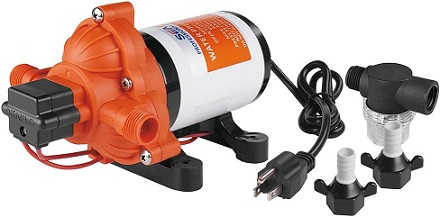
Operating on 115V AC power at just 0.75 amps, it’s energy-efficient and cost-effective. Its built-in adjustable pressure switch activates the pump at 45 PSI, ensuring consistent pressure. Installation is easy as it plugs into a standard wall outlet, no complex wiring needed.
Best Features
- It offers up to 3.3 GPM flow rate
- The pressure level is up to 45 PSI
- It is made up of metal
- Automatic shut off at 45 PSI pressure level
Pros
- UL 778 and CSA 22.2 certified pump
- It has a built-in adjustable pressure switch
- Works with standard wall outlet
Cons
- Flow rate is comparatively lower than other options
2. KolerFlo Pressure Booster Pump
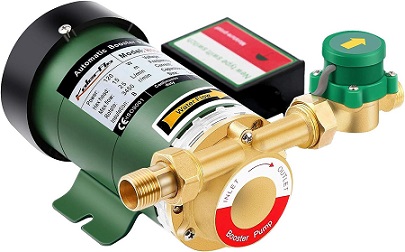
With a 1/2″ NPT connection, it handles liquid temperatures from 0 °F to +212 °F. Its built-in water flow switch ensures automatic adjustment to maintain steady pressure in household water tanks. Featuring a sturdy 120-watt motor, high-quality flow switch, and brass fittings, it promises durability and reliability.
Best Features
- It offers up to 6.6 GPM flow rate
- The pressure level is up to 21.7 PSI
- It is made up of brass
- Powered by a 120 Watts motor
Pros
- Relatively higher flow rate
- Installation is very easy
- 0 °F to +212 °F water temperature range
Cons
- Pressure level is quite low
3. AQUASTRONG Pressure Booster Pump
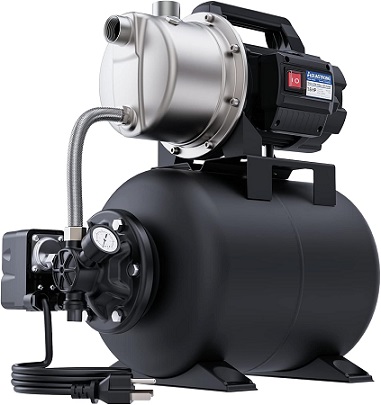
With a maximum flow rate of 1320 gallons per hour and a stainless steel housing for corrosion resistance, it’s ideal for irrigation and domestic water supply. Equipped with a pressure switch and temperature sensing, it operates automatically and safeguards the motor from damage.
Best Features
- It offers up to 22 GPM flow rate
- The pressure level is up to 109 PSI
- It is made up of stainless steel
- 5 feet UL power cord is included
Pros
- One of the most powerful options for a water pressure booster pump
- Build quality is very good
- Very high flow rate is available
Cons
- Very expensive choice for a household water pressure booster pump
4. ECO-WORTHY Pressure Booster Pump
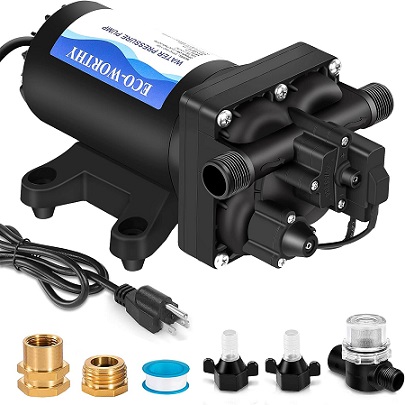
It self-primes up to 9.8 vertical feet and can lift water up to 131 feet, meeting diverse needs easily. The pump has a built-in on-demand pressure switch, ensuring consistent pressure when the faucet is open and safety features like CE certification and thermal overload protection for worry-free use.
Best Features
- It offers up to 5.5 GPM flow rate
- The pressure level is up to 70 PSI
- It is made up of plastic
- CE-certified water pressure booster pump
Pros
- Suitable for operating for more than 1 hour at a time
- It has 4 years of warranty
- Self priming capacity is pretty good
Cons
- Overall build quality could have been better
5. Simer Pressure Booster Pump
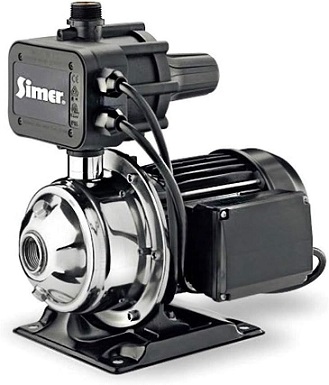
Durability is a key feature, thanks to its rust-proof stainless steel construction, ensuring longevity despite constant water exposure. With up to 40 PSI of added pressure, it ensures consistent and reliable water supply for diverse applications. Checking out Simer’s specifications and quality is definitely worthwhile.
Best Features
- It offers up to 24 GPM flow rate
- The pressure level is up to 51 PSI
- It is made up of stainless steel
- Completely rust and corrosion-proof build
Pros
- It offers up to 40 PSI additional pressure
- Works over standard household VAC output
- 6 foot long power cord is included in the package
Cons
- Very expensive option compared to other water pressure booster pumps
6. Wassermann Pressure Booster Pump
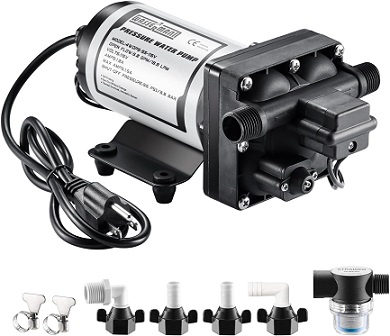
The built-in bypass switch minimizes vibration for smooth, quiet operation. Compact in size at 9.26 x 4.92 x 4.33 inches, it fits seamlessly into various systems like RVs, kitchens, bathrooms, boats, and gardens. Explore WASSERMANN’s range for more options before deciding.
Best Features
- It offers up to 5 GPM flow rate
- The pressure level is up to 55 PSI
- It is made up of plastic
- Compact design for hassle-free installation
Pros
- Built-in bypass switch
- Relatively cheaper option for a domestic pump
- All accessories are included in the package
Cons
- Plastic body may pose a disadvantage as far as build quality is considered
Buying Guide For The Best Water Pressure Booster Pump
When selecting the best water pressure booster pump for your needs, understanding the key factors that influence performance and suitability is crucial. Below, we delve into the factors to consider:
1. Type Of Pump
a. Centrifugal Pumps
Why It Matters: Centrifugal pumps are widely used for their simplicity, effectiveness, and ability to move water rapidly. They are suitable for residential and commercial applications where a significant increase in water pressure is not required but a steady flow is needed.
What to Look For: Consider centrifugal pumps if you need a flow rate typically between 15 to 5000 gallons per minute (GPM). They are best for applications requiring a head (height of water movement) of less than 700 feet. For home use, a pump with a capacity of 15 to 50 GPM might be sufficient, depending on the number of water fixtures and simultaneous usage.
b. Positive Displacement Pumps
Why It Matters: Positive displacement pumps are ideal for applications requiring a constant flow rate, regardless of the system pressure. They excel in situations where high pressure is needed over a shorter distance.
What to Look For: These pumps are a good choice if you require a consistent flow rate at a specified RPM (Revolutions Per Minute). They are suitable for both low and high-viscosity fluids, making them versatile for different types of fluids beyond just water. Flow rates can vary widely, so select based on your specific consistent flow needs.
c. Variable Speed Pumps
Why It Matters: Variable speed pumps adjust their operation based on the demand, leading to energy savings and a more consistent water pressure experience. They are particularly effective in applications where the water usage varies significantly throughout the day.
What to Look For: Look for pumps that can adjust flow rates from as low as 5 GPM to over 50 GPM, depending on instantaneous usage. These pumps are ideal for maintaining a constant pressure, even when multiple fixtures are used simultaneously.
2. Flow Rate
Why It Matters: The flow rate, typically measured in gallons per minute (GPM), is indicative of how much water a pump can move within a minute. It is a critical measure of the pump’s capacity to deliver water to your faucets, showers, and appliances. A higher flow rate means more water can be delivered simultaneously, essential for larger homes or buildings with high water demand.
What to Look For: Assess your water usage needs by considering the number of water fixtures in your property and their simultaneous usage. Residential applications might require flow rates between 15 to 40 GPM, while commercial or industrial settings could demand anywhere from 40 to over 90 GPM, depending on the scale of operations and simultaneous water usage across various fixtures.
3. Maximum Pressure
Why It Matters: Maximum pressure, measured in pounds per square inch (PSI), indicates the highest level of water pressure the pump can achieve. This is vital for overcoming gravity (in multi-story buildings), long distances from the water source, or to significantly improve water pressure in a system with naturally low pressure.
What to Look For: Determine the pressure increase you need by evaluating your current water pressure and the desired pressure. If your home’s water pressure is around 30 PSI and you wish to reach the standard residential pressure of 60-70 PSI, look for a pump with a maximum pressure capability of at least 40 PSI. Pumps on the market typically offer maximum pressures from 40 to 150 PSI, catering to a wide range of needs.
4. Connection Size
Why It Matters: The connection size of a water pressure booster pump, usually measured in inches, is crucial for ensuring compatibility with your existing plumbing system. The right connection size ensures a seamless, leak-free installation and optimal water flow through the pump.
What to Look For: Check the size of your current plumbing pipes. Most residential plumbing systems use ½ inch or 1-inch connections, while commercial systems may use 1½ inches or larger. Pumps are available with connection sizes ranging from ½ inch to 2 inches or more. Choosing a pump with a connection size that matches your plumbing ensures efficient water flow and reduces the need for additional adapters or modifications.
5. Noise Level
Why It Matters: The noise level of a booster pump, measured in decibels (dB), is an important consideration for residential areas or workplaces where excessive noise could be disruptive. A quieter pump enhances the comfort and usability of your space.
What to Look For: Look for pumps with noise levels less than 75 dB for residential applications, as this range is generally considered acceptable for indoor environments. Some of the most advanced pumps are designed to operate quietly, producing noise levels as low as 45 dB. The inclusion of noise-dampening materials and technologies is also a plus.
6. Build Quality
Why It Matters: The build quality determines the longevity and reliability of the booster pump. High-quality construction minimizes the risk of leaks, breakdowns, and frequent maintenance, ensuring consistent water pressure over time.
What to Look For: Seek pumps that feature robust, corrosion-resistant materials and components. Look for pumps that are designed with stainless steel or alloy parts, and ensure that the product has a solid reputation for durability. Additionally, pumps that come with a warranty of at least 2-5 years can often indicate superior build quality.
7. Material
Why It Matters: The material of the water pressure booster pump affects its durability, efficiency, and suitability for different types of water (e.g., hard, soft, or chemically treated). Corrosion-resistant materials extend the pump’s lifespan and maintain water quality.
What to Look For: Stainless steel is widely regarded for its strength and resistance to corrosion, making it an ideal material for many booster pumps. However, for certain applications, other materials such as cast iron or composite plastics may be more appropriate. Ensure the material is suitable for the specific type of water in your system and the environmental conditions where the pump will be installed.
8. Installation
Why It Matters: Easy and straightforward installation can significantly reduce initial setup costs and time. A booster pump that is difficult to install may require professional assistance, adding to the overall expense.
What to Look For: Look for pumps that come with clear, comprehensive installation instructions or kits. Pumps designed for easy integration with existing plumbing systems, featuring standard connection sizes and minimal additional requirements for operation, are ideal. Consider models that are known for their plug-and-play capabilities, especially if you plan to install the pump yourself.
Pressure Booster pump – FAQs
Ans: The installation of a water pressure booster pump can be a complex and potentially hazardous task, depending on the specific requirements of your plumbing system and the type of pump you’re using. While it is possible for individuals with a good understanding of plumbing and electrical systems to install a booster pump on their own, it is generally recommended to seek professional help.
Ans: Yes, frequent maintenance is crucial for a water pressure booster pump to ensure its proper operation, longevity, and efficiency. The specific maintenance schedule and tasks may vary depending on the type of booster pump, its usage, and the manufacturer’s recommendations. Regular maintenance helps identify and address potential issues before they become major problems. By routinely inspecting and servicing the pump, you can catch issues such as leaks, worn components, or declining performance early on, reducing the risk of costly repairs or replacements.
Ans: The lifespan of a booster pump can vary widely depending on several factors, including the quality of the pump, its usage, maintenance, and the specific conditions of the installation. In general, a well-maintained booster pump can be expected to last anywhere from 10 to 15 years or more. The quality of the pump and its components plays a significant role in its lifespan. High-quality pumps with durable materials and construction are more likely to last longer than cheaper alternatives. Regular maintenance is also crucial for extending the life of a booster pump. Routine inspections, cleaning, lubrication, and replacement of worn or damaged parts can help prevent premature wear and ensure the pump operates efficiently.
Conclusion
Water pressure booster pumps are essential for maintaining adequate water pressure and flow, whether for residential or industrial use. When choosing a pump, factors like pump type, required pressure, flow rate, and build quality are crucial. Booster pumps ensure reliable water supply systems, promoting convenience and resource conservation.
- For budget-friendly options, consider the Wassermann Pressure Booster Pump, offering a 5 GPM flow rate and nearly 55 PSI pressure, along with a built-in pressure switch for automatic operation.
- The SEAFLO Pressure Pump, certified for safety and self-priming up to 6 feet, is another affordable choice.
- For high-power needs, the AQUASTRONG Pressure Booster Pump with Pressure Tank offers a flow rate of 22 GPM and 109 PSI pressure, with stainless steel construction and a 5-gallon pressure tank for longevity.
Check out our buying guide for more information and recommendations tailored to your needs.

